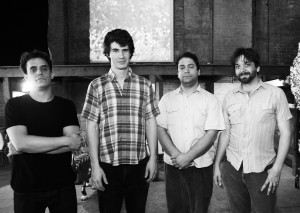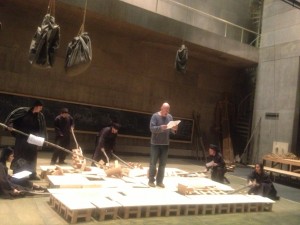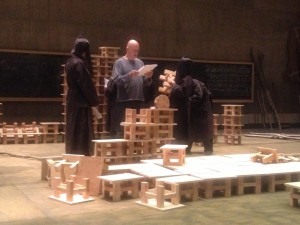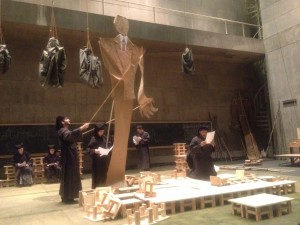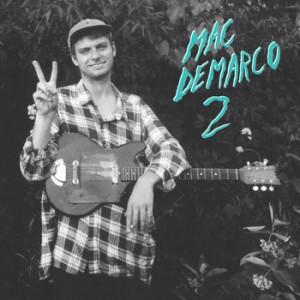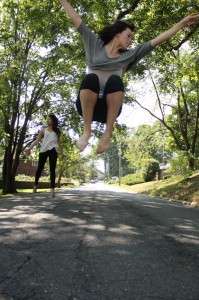Rebecca Seidel attends “Andrew Raftery: Open House,” an exhibition presented by the Davison Art Center, through Sunday, December 9, 2012.

There is only a week left to visit Andrew Raftery: Open House, a five-part series of printed engravings and related work by contemporary artist Andrew Raftery. Nobody should miss the opportunity to get lost in the boundless details and rich content of Mr. Raftery’s work.
In the five engravings on display, Mr. Raftery illustrates several rooms in a house that is on the real estate market, allowing us an inside view as potential buyers examine the place. Together, the engravings constitute a single place and moment, viewed from varied perspectives. Meticulously executed, these scenes offer a compelling snapshot of an upper-middle class American household. They also explore a familiar interaction—that between realtors and buyers—in an intriguingly non-verbal way.
The figures in the prints are lifelike and dynamic, the architecture precisely proportioned. It’s almost impossible to comprehend the years of thought, planning, and meticulous preparatory work that Mr. Raftery put into these engravings—the endeavor spanned six years, culminating in 2008. But spend some time at the gallery, and you will begin to understand and appreciate the depth of his focus.
In addition to showcasing the engravings themselves, the exhibit guides viewers through Mr. Raftery’s preparatory process. There are over 50 working drawings on display alongside the five engravings. Among these samples, we see pen-and-ink architectural studies, nude and clothed sketches of the figures who appear in the engravings, and ink-wash tone studies of those same figures. Mr. Raftery also constructed scale models of the rooms, studying the proportions of both the rooms themselves and the people wandering through them. These models reveal the astounding thoroughness of Mr. Raftery’s creative process. They also give you a sense that he enjoyed the challenge of bringing this house and the people in it to life through such exhaustive planning.
The display of all these stages of preparation showcases not only Mr. Raftery’s concern with detail and precision, but also his deftness and versatility as an artist. The preliminary drawings are masterful works of art themselves.
The exhibit is designed so that for each scene, you have to walk through all the preliminary work before arriving at the final product. As I walked around the perimeter of the exhibit, I found myself getting anxious to arrive at the published scenes so that I would better understand the context of the preliminary drawings. While this was a confusing experience at times, the setup was certainly effective in paralleling Mr. Raftery’s process of creation. It made me appreciate more thoroughly the amount of preparation and thought that went into the final five prints.
In these scenes, the thoroughness of Mr. Raftery’s work extends down to the most minute details. The engravings feature identifiable brand-name housewares and appliances, such as a Michael Graves/Alessi kettle in the kitchen. The house’s walls feature known works of art, including Robert Maplethorpe’s “Orchid” and David Hockne’s “Paper Pools.” Mr. Raftery even gives himself a shout-out, displaying one of his own works of art in the master bedroom. These details reveal a lot about the homeowners—although interestingly, the homeowners themselves never appear. The house is on display both to the prospective buyers and to us as viewers—and where the house-hoppers see tasteful décor and good architecture, we see reflections of upper-middle class America and consumer culture. Our voyeuristic vantage point allows us to see a bigger picture, in addition to appreciating the tiny details. Despite the narrow scope of its subject matter—or perhaps because of it—this exhibit digs deep into a subset of American culture.
The figures in the engravings, while rather generic in their features and physiques, evoke clear sentiments with their body language—feelings of curiosity, uncertainty, and satisfaction all radiate from the paper. People of all ages walk through the open house: in the first scene, we see a realtor handing something to an older couple in the living room, while a younger couple enters the room from the back. Other scenes include babies and small children. The interactions between realtor and buyer, between the old and the young, infuse these engravings with vital energy. We can see how much thought Mr. Raftery put into these figures through his exhaustive preparatory drawings, a great number of which appear alongside the final engravings. His studies of form and shadow and position pay off tremendously.
Despite the thoroughness of the engravings, and despite the specificity of so many details, much remains unseen in this open house. We don’t know the context in which the house is being sold, or the background of the potential buyers. Questions of family dynamics and cultural climate come into play. Mr. Raftery infuses a fairly commonplace setting with boundless questions, layering all the exquisite details with pockets of uncertainty and room for speculation.
Mr. Raftery draws inspiration from Claude Mellan, a 17th-century engraver who formed images and evoked tone using parallel lines of varying densities. This influence manifests itself overwhelmingly in Open House: the images we see are composites of dizzying numbers of parallel lines. Mr. Raftery executes this engraving style perfectly.
In a recent interview at the Rhode Island School of Design, where he resides on the faculty, Mr. Raftery said regarding Open House, “I like this idea that we can look at spaces and kind of read them. I thought the layers of history that are embodied in my style would relate to the layers of history that were embodied in this subject.” This certainly rings true in the exhibit. The form and subject not only compliment one another perfectly—they also enhance one another in unexpected ways. Engraving is often considered a dated art form, but Raftery’s implementation of formal engraving techniques—especially his use of hatched lines for tone—help him capture a familiar snapshot of modern culture in a realistic and timeless way.
As the preparatory drawings and models make clear, this exhibit is as much about the final products of Mr. Raftery’s work as the meticulous effort that went into it. To emphasize this, one feature of the exhibit is a video of Mr. Raftery explaining and demonstrating the process of engraving. He showed how he uses a tool called a burin, with a rounded handle and a sharp steel shaft, to engrave images onto a copper plate. He also guides us through the process of transferring the work from engraved metal to printed paper. This explanatory portion is located at the end of the exhibit, immediately following the fifth and final scene. The video enhanced my appreciation of the art of engraving, and of the prodigious skill it requires. I felt exhausted just thinking about the level of concentration that this type of printmaking requires, but Mr. Raftery displays a genuine delight in the entire process.
With Open House, Mr. Raftery showcases his exceptional skills as both an artist and an observer of life’s everyday intricacies. In the process, he breathes new life into an age-old art form, offering a lesson in the virtues of focus and precision.
Don’t miss Andrew Raftery: Open House at the Davison Art Center, open through Sunday, December 9, 2012.


